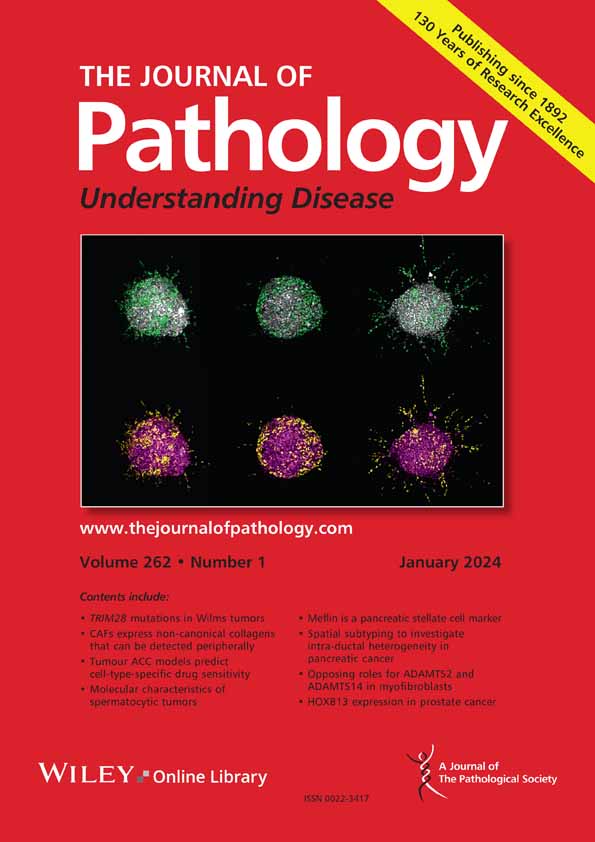Corey David Chan, Marcus J Brookes, Toni A Pringle, Rahul Pal, Riya Tanwani, Alastair D Burt, James C Knight, Anand Tn Kumar, Kenneth S Rankin
求助PDF
{"title":"Investigating the mechanisms of indocyanine green tumour uptake in sarcoma cell lines and ex vivo human tissue.","authors":"Corey David Chan, Marcus J Brookes, Toni A Pringle, Rahul Pal, Riya Tanwani, Alastair D Burt, James C Knight, Anand Tn Kumar, Kenneth S Rankin","doi":"10.1002/path.6473","DOIUrl":null,"url":null,"abstract":"<p><p>Indocyanine green (ICG) is a well-established near-infrared dye which has been used clinically for several decades. Recently, it has been utilised for fluorescence-guided surgery in a range of solid cancer types, including sarcoma, with the aim of reducing the positive margin rate. The increased uptake and retention of ICG within tumours, compared with normal tissue, gives surgeons a visual reference to aid resection when viewed through a near-infrared camera. However, the mechanisms of this process are poorly understood. We performed in vitro ICG cellular uptake studies across a panel of sarcoma cell lines exhibiting varying proliferation rates and phenotypes. The effects of ICG concentration, incubation time, inhibition of clathrin-mediated endocytosis, and cell line proliferation rate on the cellular uptake of ICG were investigated using fluorescence microscopy and flow cytometry. Subcellular localisation of intracellular ICG was assessed via colocalization with a lysosomal marker. The spatial distribution of ICG in patient tumour tissue following fluorescence-guided surgery was assessed by high-resolution tissue imaging and quantified using fluorescence lifetime imaging. In vitro results showed that the cell line proliferation rate correlated significantly with ICG uptake (Spearman's rank correlation coefficient = 1.00, p < 0.001), and maximum ICG uptake was observed after 24 h incubation. ICG cellular uptake was significantly reduced by inhibition of clathrin-mediated endocytosis (p = 0.0004), and intracellular ICG significantly colocalized with a lysosomal marker within 30 min (Pearson's r = 0.8). On histological analysis of tumour tissue from three different sarcoma subtypes, ICG was observed within sarcoma cells as well as accumulating in paucicellular areas of haemorrhage and necrosis within the tumour microenvironment. Through quantification of fluorescence lifetime imaging of ICG, we were able to differentiate sarcoma cells from haemorrhage and necrosis within tumour tissue. Combining in vitro data with analysis of patient tissue, we propose that the uptake and accumulation of ICG in sarcomas is driven by a synergistic mechanism involving the enhanced permeability and retention effect combined with active tumour cell endocytosis of the dye. © 2025 The Author(s). The Journal of Pathology published by John Wiley & Sons Ltd on behalf of The Pathological Society of Great Britain and Ireland.</p>","PeriodicalId":232,"journal":{"name":"The Journal of Pathology","volume":" ","pages":""},"PeriodicalIF":5.2000,"publicationDate":"2025-09-10","publicationTypes":"Journal Article","fieldsOfStudy":null,"isOpenAccess":false,"openAccessPdf":"","citationCount":"0","resultStr":null,"platform":"Semanticscholar","paperid":null,"PeriodicalName":"The Journal of Pathology","FirstCategoryId":"3","ListUrlMain":"https://doi.org/10.1002/path.6473","RegionNum":2,"RegionCategory":"医学","ArticlePicture":[],"TitleCN":null,"AbstractTextCN":null,"PMCID":null,"EPubDate":"","PubModel":"","JCR":"Q1","JCRName":"ONCOLOGY","Score":null,"Total":0}
引用次数: 0
引用
批量引用
Abstract
Indocyanine green (ICG) is a well-established near-infrared dye which has been used clinically for several decades. Recently, it has been utilised for fluorescence-guided surgery in a range of solid cancer types, including sarcoma, with the aim of reducing the positive margin rate. The increased uptake and retention of ICG within tumours, compared with normal tissue, gives surgeons a visual reference to aid resection when viewed through a near-infrared camera. However, the mechanisms of this process are poorly understood. We performed in vitro ICG cellular uptake studies across a panel of sarcoma cell lines exhibiting varying proliferation rates and phenotypes. The effects of ICG concentration, incubation time, inhibition of clathrin-mediated endocytosis, and cell line proliferation rate on the cellular uptake of ICG were investigated using fluorescence microscopy and flow cytometry. Subcellular localisation of intracellular ICG was assessed via colocalization with a lysosomal marker. The spatial distribution of ICG in patient tumour tissue following fluorescence-guided surgery was assessed by high-resolution tissue imaging and quantified using fluorescence lifetime imaging. In vitro results showed that the cell line proliferation rate correlated significantly with ICG uptake (Spearman's rank correlation coefficient = 1.00, p < 0.001), and maximum ICG uptake was observed after 24 h incubation. ICG cellular uptake was significantly reduced by inhibition of clathrin-mediated endocytosis (p = 0.0004), and intracellular ICG significantly colocalized with a lysosomal marker within 30 min (Pearson's r = 0.8). On histological analysis of tumour tissue from three different sarcoma subtypes, ICG was observed within sarcoma cells as well as accumulating in paucicellular areas of haemorrhage and necrosis within the tumour microenvironment. Through quantification of fluorescence lifetime imaging of ICG, we were able to differentiate sarcoma cells from haemorrhage and necrosis within tumour tissue. Combining in vitro data with analysis of patient tissue, we propose that the uptake and accumulation of ICG in sarcomas is driven by a synergistic mechanism involving the enhanced permeability and retention effect combined with active tumour cell endocytosis of the dye. © 2025 The Author(s). The Journal of Pathology published by John Wiley & Sons Ltd on behalf of The Pathological Society of Great Britain and Ireland.
研究在肉瘤细胞系和离体人体组织中吲哚菁绿肿瘤摄取的机制。
吲哚菁绿(ICG)是一种成熟的近红外染料,已在临床上使用了几十年。最近,它已被用于荧光引导的一系列实体癌类型的手术,包括肉瘤,目的是降低阳性边缘率。与正常组织相比,肿瘤中ICG的吸收和保留增加,当通过近红外摄像机观察时,为外科医生提供了辅助切除的视觉参考。然而,人们对这一过程的机制知之甚少。我们对一组表现出不同增殖率和表型的肉瘤细胞系进行了体外ICG细胞摄取研究。采用荧光显微镜和流式细胞术研究ICG浓度、培养时间、网格蛋白介导的胞吞作用抑制和细胞系增殖率对ICG细胞摄取的影响。细胞内ICG的亚细胞定位通过溶酶体标记共定位来评估。通过高分辨率组织成像评估荧光引导手术后患者肿瘤组织中ICG的空间分布,并使用荧光寿命成像进行量化。体外结果显示,细胞系增殖率与ICG摄取显著相关(Spearman秩相关系数= 1.00,p
本文章由计算机程序翻译,如有差异,请以英文原文为准。

 求助内容:
求助内容: 应助结果提醒方式:
应助结果提醒方式:


